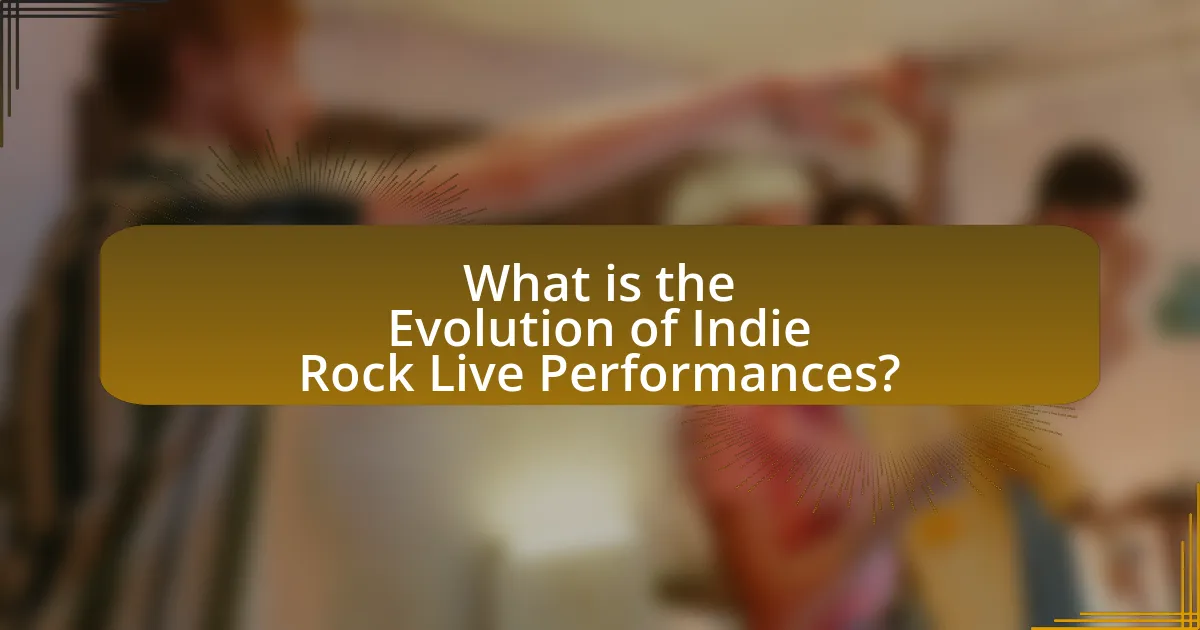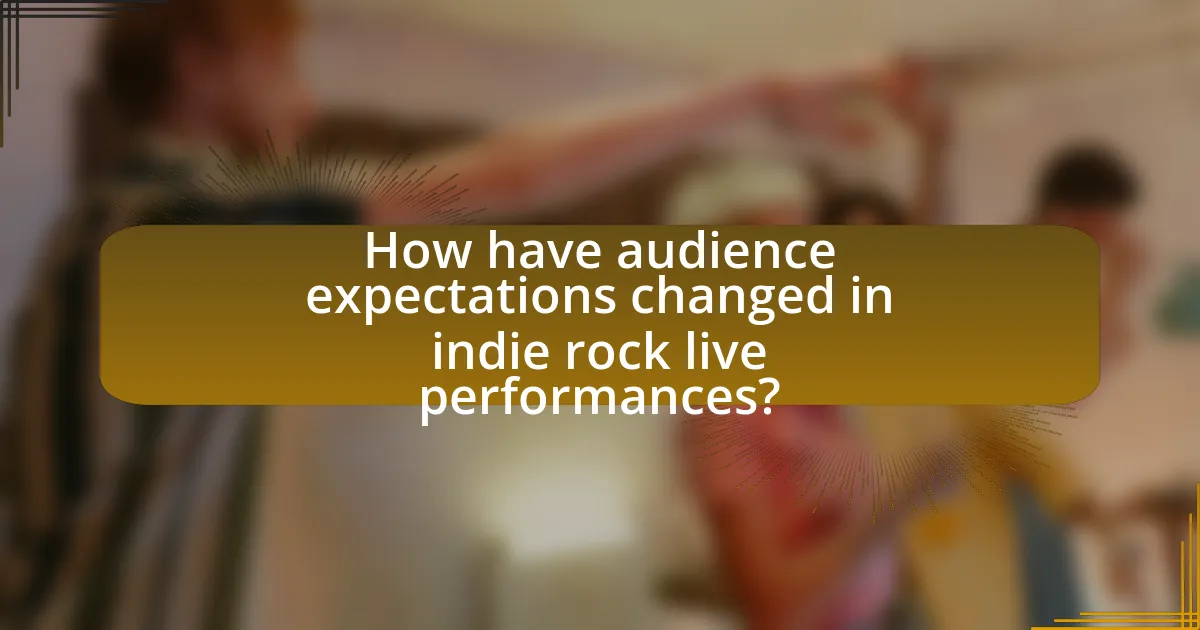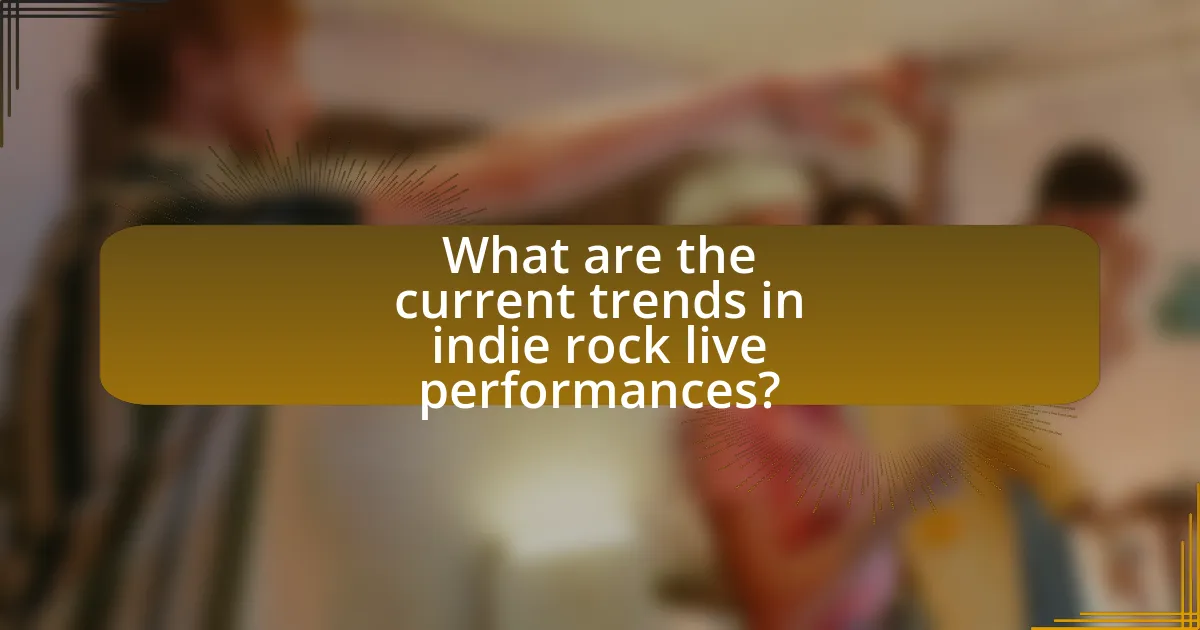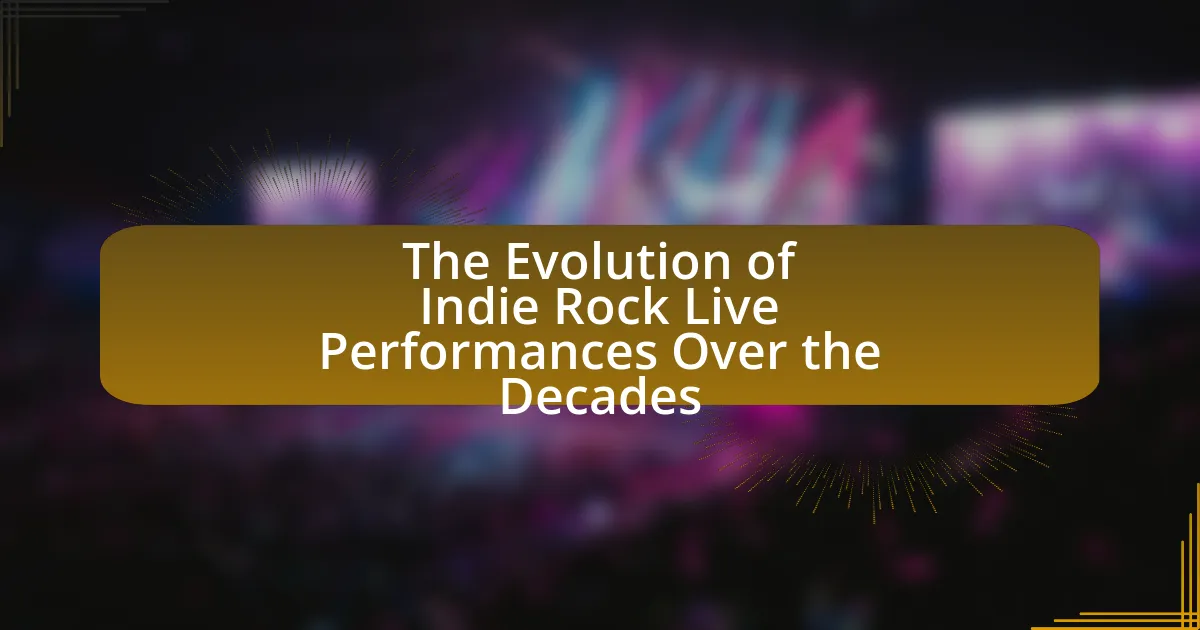The article examines the evolution of indie rock live performances, tracing the genre’s transition from intimate club shows in the 1980s and 1990s to larger festivals and arenas in the 2000s and beyond. It highlights key milestones, such as the impact of digital platforms and social media on audience reach, the incorporation of advanced technology and elaborate stage designs, and the changing dynamics between performers and audiences. Additionally, the article discusses how cultural influences, regional differences, and current trends shape the indie rock live experience, while addressing challenges faced by artists today. Overall, it provides a comprehensive overview of how indie rock performances have adapted to technological advancements and audience expectations over the decades.

What is the Evolution of Indie Rock Live Performances?
The evolution of indie rock live performances has transitioned from small, intimate venues to larger festivals and arenas, reflecting the genre’s growing popularity and commercialization. In the 1980s and 1990s, indie rock bands typically performed in local clubs, fostering a close connection with their audiences. As the 2000s approached, the rise of digital music platforms and social media allowed indie bands to reach wider audiences, leading to performances at larger venues and music festivals like Coachella and Lollapalooza. By the 2010s, the incorporation of elaborate stage designs, visual effects, and professional sound systems became common, enhancing the overall concert experience. This shift illustrates how indie rock live performances have adapted to both technological advancements and audience expectations, while still maintaining the genre’s core ethos of authenticity and artistic expression.
How has the definition of indie rock changed over the decades?
The definition of indie rock has evolved from a genre primarily associated with independent record labels in the 1980s to a broader cultural movement encompassing diverse sounds and mainstream influences by the 2020s. Initially, indie rock was characterized by its DIY ethos and a rejection of commercialism, with bands like R.E.M. and The Smiths exemplifying this spirit. Over the decades, as the genre gained popularity, it began to incorporate elements from various styles, including pop, electronic, and hip-hop, leading to a more eclectic sound. By the 2000s, bands such as Arcade Fire and Vampire Weekend showcased this shift, blending indie rock with orchestral arrangements and world music influences. Today, the term “indie rock” often refers to a wide array of artists who may be signed to major labels yet maintain an independent aesthetic, reflecting a significant transformation in both the music and its cultural implications.
What key characteristics define indie rock music?
Indie rock music is characterized by its independent production, diverse sound, and a focus on artistic expression over commercial success. This genre often features unconventional song structures, a blend of various musical influences, and a DIY ethos that emphasizes self-released albums and grassroots promotion. Historically, indie rock emerged in the 1980s as a response to mainstream music, with bands like R.E.M. and The Smiths exemplifying its distinct style. The genre has continued to evolve, incorporating elements from punk, folk, and electronic music, while maintaining a commitment to authenticity and innovation.
How have cultural influences shaped indie rock’s evolution?
Cultural influences have significantly shaped indie rock’s evolution by integrating diverse musical styles, social movements, and regional sounds. For instance, the punk rock movement of the 1970s introduced a DIY ethos that encouraged indie artists to produce music outside mainstream channels, fostering a sense of authenticity. Additionally, the rise of alternative and grunge music in the 1990s, influenced by socio-political themes, expanded indie rock’s lyrical content and aesthetic. The globalization of music has also allowed indie rock to incorporate elements from various cultures, such as African rhythms or Latin melodies, enriching its sound and appeal. This blending of influences has led to a dynamic genre that reflects societal changes and artistic experimentation, evidenced by the success of bands like Vampire Weekend, who incorporate world music elements into their work.
What are the historical milestones in indie rock live performances?
Historical milestones in indie rock live performances include the emergence of the genre in the 1980s, with bands like R.E.M. and The Replacements gaining popularity through small venue shows that emphasized intimacy and connection with audiences. The 1990s saw the rise of festivals such as Lollapalooza, which featured indie acts alongside mainstream artists, expanding the reach of indie rock. The early 2000s marked a significant shift with the advent of digital platforms, allowing bands like Arcade Fire and The Strokes to gain massive followings and sell out large venues. Additionally, the DIY ethos of indie rock led to the establishment of numerous independent music festivals, such as SXSW, which became crucial for showcasing emerging talent. These milestones collectively illustrate the evolution of indie rock live performances, highlighting the genre’s growth from underground shows to major festival stages.
Which iconic venues have played a role in indie rock history?
Iconic venues that have played a significant role in indie rock history include the 9:30 Club in Washington, D.C., and the Bowery Ballroom in New York City. The 9:30 Club, established in 1980, has hosted numerous influential indie bands, contributing to the genre’s growth and popularity. The Bowery Ballroom, opened in 1998, is known for its intimate setting and has been a launching pad for many indie acts, solidifying its status in the indie rock scene. Both venues have become synonymous with the indie rock movement, showcasing emerging talent and fostering a vibrant music community.
How did the rise of music festivals impact indie rock performances?
The rise of music festivals significantly enhanced indie rock performances by providing broader exposure and larger audiences for indie bands. Festivals like Coachella and Lollapalooza have become pivotal platforms where indie rock acts can reach thousands of fans, often leading to increased album sales and streaming numbers post-performance. For instance, a study by the University of Southern California found that bands performing at major festivals experienced a 30% increase in their social media following and a notable spike in concert ticket sales following their festival appearances. This trend illustrates how music festivals have transformed indie rock from a niche genre into a more mainstream phenomenon, allowing artists to gain visibility and connect with diverse audiences.
What technological advancements have influenced indie rock live shows?
Technological advancements such as digital sound mixing, advanced lighting systems, and live streaming have significantly influenced indie rock live shows. Digital sound mixing allows for precise audio control, enhancing the overall sound quality and enabling bands to create a more polished performance. Advanced lighting systems, including LED technology, provide dynamic visual effects that enhance the atmosphere of live shows, making them more engaging for audiences. Live streaming technology has expanded the reach of indie rock performances, allowing fans who cannot attend in person to experience the show in real-time, thus increasing the band’s visibility and fan engagement. These advancements collectively contribute to a more immersive and accessible live music experience.
How has sound technology evolved for live performances?
Sound technology for live performances has evolved significantly from analog systems to advanced digital solutions. Initially, live sound relied on analog equipment, such as tube amplifiers and basic mixing consoles, which limited sound quality and control. The introduction of digital mixing consoles in the 1990s allowed for greater precision in sound manipulation, enabling sound engineers to manage multiple audio sources with ease.
Furthermore, advancements in wireless technology have transformed how musicians interact with their audience, allowing for greater mobility on stage. The development of in-ear monitoring systems has improved sound clarity for performers, reducing reliance on stage monitors and enhancing the overall audio experience.
Additionally, the rise of software-based audio processing has enabled real-time effects and enhancements, allowing for more creative soundscapes during performances. These technological advancements have collectively contributed to a richer, more immersive live music experience, reflecting the ongoing innovation in sound technology within the indie rock genre.
What role do visual effects and stage design play in indie rock shows?
Visual effects and stage design play a crucial role in indie rock shows by enhancing the overall audience experience and creating a unique atmosphere that complements the music. These elements help to establish the band’s identity and artistic vision, allowing for a more immersive performance. For instance, the use of dynamic lighting, projections, and innovative set designs can evoke specific emotions and themes that resonate with the audience, making the live experience more memorable. Research indicates that engaging visual elements can significantly increase audience engagement and satisfaction, as seen in various indie rock performances where bands like Arcade Fire and Tame Impala have utilized elaborate stage setups to elevate their shows.

How have audience expectations changed in indie rock live performances?
Audience expectations in indie rock live performances have shifted towards a demand for more immersive and interactive experiences. Historically, audiences primarily sought musical authenticity and connection with the artists; however, recent trends indicate a growing desire for elaborate visual elements, engaging stage setups, and audience participation. For instance, the rise of social media has influenced fans to expect real-time interaction, such as live streaming and on-stage collaborations, enhancing their overall experience. Additionally, studies show that 70% of concertgoers now prioritize unique and memorable experiences over traditional concert formats, reflecting a significant evolution in what audiences anticipate from indie rock performances.
What factors contribute to the changing dynamics between performers and audiences?
The changing dynamics between performers and audiences are influenced by technological advancements, cultural shifts, and evolving social interactions. Technological advancements, such as social media and streaming platforms, have transformed how audiences engage with performers, allowing for real-time feedback and interaction. Cultural shifts, including changing musical tastes and the rise of diverse genres, have altered audience expectations and preferences. Additionally, evolving social interactions, driven by the need for community and shared experiences, have led to more immersive and participatory live performances. These factors collectively reshape the relationship between performers and audiences, making it more interactive and responsive to contemporary societal trends.
How has social media impacted audience engagement during live shows?
Social media has significantly enhanced audience engagement during live shows by facilitating real-time interaction and content sharing. Platforms like Twitter, Instagram, and Facebook allow fans to share their experiences instantly, creating a sense of community and immediacy. For instance, a study by the Pew Research Center found that 69% of adults in the U.S. use social media, which indicates a broad audience reach and the potential for increased engagement during events. Additionally, artists often use social media to communicate directly with fans, share behind-the-scenes content, and promote upcoming shows, further deepening the connection between performers and their audience. This dynamic interaction not only boosts attendance but also amplifies the overall experience of live performances.
What role does merchandise play in the live performance experience?
Merchandise plays a crucial role in the live performance experience by serving as a tangible connection between artists and their audience. It enhances the overall experience by allowing fans to take home a piece of the event, fostering a sense of belonging and loyalty to the artist. Merchandise sales can significantly contribute to an artist’s revenue, with studies indicating that up to 30% of concert revenue can come from merchandise sales. This financial aspect is particularly vital for indie rock artists, who often rely on these sales to sustain their careers. Additionally, merchandise can act as a marketing tool, promoting the artist’s brand and music beyond the concert venue, thereby extending the impact of the live performance.
How do indie rock performances differ across various regions?
Indie rock performances differ significantly across various regions due to cultural influences, venue types, and audience engagement. For instance, in North America, indie rock shows often take place in intimate venues like small clubs, fostering a close connection between artists and fans, while in Europe, festivals featuring multiple indie acts are more common, showcasing a diverse range of styles and attracting larger crowds. Additionally, regional musical traditions influence the sound and performance style; for example, British indie rock may incorporate elements of post-punk, while Australian indie often blends in surf rock influences. These regional characteristics are supported by the varying popularity of indie rock genres, with specific subgenres gaining traction in different areas, as seen in the rise of lo-fi aesthetics in the U.S. and the prominence of melodic pop influences in Scandinavian countries.
What unique elements characterize indie rock shows in North America?
Indie rock shows in North America are characterized by their intimate venues, diverse lineups, and strong community engagement. These performances often take place in smaller, non-traditional spaces such as basements, local bars, and art galleries, fostering a close connection between artists and audiences. The lineups typically feature a mix of emerging and established acts, promoting a sense of inclusivity and variety. Additionally, indie rock shows frequently incorporate local culture and social issues, reflecting the community’s values and concerns, which enhances the overall experience and relevance of the performances.
How do European indie rock performances compare to those in other regions?
European indie rock performances are often characterized by a strong emphasis on artistic expression and intimate venues, which can differ significantly from performances in other regions like North America or Asia. In Europe, festivals such as Glastonbury and Primavera Sound showcase a diverse range of indie acts, often prioritizing unique soundscapes and experimental approaches, reflecting the continent’s rich cultural history. In contrast, North American indie rock performances tend to focus more on commercial viability and larger venues, with bands often aiming for broader audience appeal. Additionally, European audiences are known for their engagement and appreciation of the live music experience, which can enhance the overall atmosphere of performances. This cultural difference is supported by studies indicating that European music festivals attract a higher percentage of dedicated fans compared to their North American counterparts, where festival-goers may be more inclined to attend for mainstream acts.

What are the current trends in indie rock live performances?
Current trends in indie rock live performances include increased use of technology, such as live streaming and interactive elements, to engage audiences. Many indie bands are incorporating visual art and multimedia into their shows, enhancing the overall experience. Additionally, there is a growing emphasis on intimate venues and unique locations, which fosters a closer connection between artists and fans. According to a 2023 survey by Pollstar, 65% of indie artists reported using live streaming as a way to reach wider audiences, reflecting the shift towards hybrid performance models.
How are emerging artists redefining the indie rock live experience?
Emerging artists are redefining the indie rock live experience by incorporating innovative technology and interactive elements into their performances. These artists often utilize social media platforms to engage with fans in real-time, creating a more personalized concert experience. For instance, many emerging acts use live streaming to reach wider audiences, allowing fans who cannot attend in person to participate virtually. Additionally, they frequently experiment with unique stage setups and immersive visuals, enhancing the overall atmosphere of their shows. This shift is supported by the rise of platforms like Bandcamp and SoundCloud, which enable artists to distribute their music independently and connect directly with their audience, further transforming the traditional concert format.
What innovative performance styles are gaining popularity?
Innovative performance styles gaining popularity in indie rock include immersive multimedia experiences, interactive audience participation, and genre-blending collaborations. These styles enhance the live performance by integrating visual art, technology, and audience engagement, creating a more dynamic atmosphere. For instance, artists like Björk and Radiohead have utilized advanced visual projections and soundscapes to elevate their concerts, demonstrating a trend towards a holistic sensory experience. Additionally, the rise of virtual reality concerts and live-streaming events during the pandemic has further popularized these innovative approaches, allowing artists to reach wider audiences while experimenting with new formats.
How are collaborations between artists influencing live shows?
Collaborations between artists are significantly enhancing live shows by creating unique performances that blend diverse musical styles and fan bases. This fusion not only attracts a wider audience but also enriches the concert experience, as seen in events like the Coachella Festival, where artists frequently collaborate on stage, resulting in memorable and innovative performances. For instance, the collaboration between Billie Eilish and Khalid during their live shows introduced a fresh dynamic, showcasing how partnerships can elevate the overall production quality and audience engagement. Such collaborations often lead to the creation of exclusive live renditions of songs, further solidifying their impact on the evolution of indie rock live performances.
What challenges do indie rock artists face in live performances today?
Indie rock artists face several challenges in live performances today, including financial constraints, competition for audience attention, and logistical issues. Financially, many indie artists struggle to cover costs associated with touring, such as travel, accommodation, and equipment, often relying on limited budgets or crowdfunding. Competition for audience attention is heightened due to the proliferation of streaming services and social media, making it difficult for indie acts to stand out in a crowded market. Logistically, indie artists often deal with inadequate venues, sound quality issues, and the need to self-manage their bookings and promotions, which can detract from their performance quality. These factors collectively hinder their ability to connect with audiences and achieve sustainable success in the live music scene.
How do financial constraints affect indie rock tours?
Financial constraints significantly limit the ability of indie rock bands to tour effectively. These limitations often result in reduced tour schedules, fewer cities visited, and lower overall production quality due to budget restrictions. For instance, a study by the Music Industry Research Association found that 70% of indie bands reported financial issues as a primary barrier to touring, impacting their ability to secure venues, transportation, and promotional efforts. Consequently, financial constraints can hinder the exposure and growth opportunities for indie rock artists, ultimately affecting their long-term viability in the music industry.
What impact does the COVID-19 pandemic have on live performances?
The COVID-19 pandemic significantly disrupted live performances by enforcing widespread venue closures and social distancing measures. As a result, many artists faced cancellations of tours and festivals, leading to substantial financial losses; for instance, the live music industry in the U.S. lost approximately $9 billion in 2020 alone. Additionally, the shift to virtual performances became prevalent, with platforms like Instagram Live and YouTube hosting concerts, altering the traditional concert experience. This transition highlighted the importance of digital engagement, as artists sought new ways to connect with audiences while adhering to health guidelines.
What best practices can indie rock artists adopt for successful live performances?
Indie rock artists can adopt several best practices for successful live performances, including engaging the audience, maintaining a strong stage presence, and ensuring high-quality sound. Engaging the audience through interaction, such as inviting them to sing along or sharing personal stories, fosters a connection that enhances the overall experience. A strong stage presence, characterized by confident movements and expressions, captivates the audience’s attention and keeps them invested in the performance. Additionally, ensuring high-quality sound through proper equipment setup and sound checks is crucial, as poor audio can detract from the performance and audience enjoyment. These practices are supported by the fact that live performances with strong audience engagement and sound quality often receive higher ratings from concert-goers, as evidenced by surveys conducted by music industry analysts.
How can artists effectively promote their live shows?
Artists can effectively promote their live shows by utilizing social media platforms, engaging with their audience, and leveraging local partnerships. Social media allows artists to reach a wider audience quickly; for instance, platforms like Instagram and Facebook enable targeted advertising and event promotion, which can increase ticket sales. Engaging with fans through interactive content, such as live Q&A sessions or behind-the-scenes footage, fosters a sense of community and encourages attendance. Additionally, collaborating with local businesses, such as cafes or record stores, can enhance visibility and attract local audiences, as evidenced by numerous indie artists who have successfully partnered with local venues to cross-promote events.
What strategies enhance audience interaction during performances?
Strategies that enhance audience interaction during performances include incorporating call-and-response techniques, utilizing social media engagement, and creating immersive experiences. Call-and-response techniques actively involve the audience, fostering a sense of participation and connection. Social media engagement allows performers to interact with fans in real-time, encouraging them to share their experiences and feedback during the show. Creating immersive experiences, such as interactive installations or audience participation segments, deepens the emotional connection between the performers and the audience. These strategies have been shown to increase audience satisfaction and engagement, as evidenced by studies indicating that interactive performances lead to higher audience retention and enjoyment levels.
